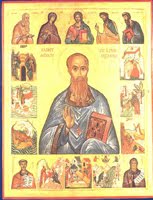Today’s post is the second written by Brad Culver who is presently homesteading in eastern Ontario and also involved in an inter-faith community. The article was first published on National ThoughtWorks Blog Brad also blogs at Living Water from an Ancient Well
And every common bush afire with God;
But only he who sees, takes off his shoes,
The rest sit round it and pluck blackberries,
And daub their natural faces unaware.
Elizabeth Barret Browning
Mundane = common place
God is found in the common places. He walked in the cool of the day. He was found in the still small voice. He rides on the wings of the wind. His glory is etched in the drifting clouds above. Present in the fragrance of a flower. Jesus lived in the ordinary world, ate ordinary food, walked among ordinary people, miracles were performed in common place in ordinary moments, at a wedding, on a hillsides, along dusty roads in the parching heat of the day.
The mundane moments of daily life are ripe with His presence, doing the dishes, driving to work, nursing the baby, waiting on tables, walking in the woods. The Celtic culture nurtured and facilitated a sacramental approach to life. Not only recognizing but expecting Gods presence in the ordinary routine and rhythm of the day.
The Celt’s recognized and celebrated the sacred in the common place. They anticipated and invited the presence into everyday activities such as setting the fireplace, milking the cow, churning the butter, ploughing the fields.
“I AM smooring the fire As the Son of Mary would smoor Blest be the house, blest be the fire, Blest be the people all.” (a blessing for preparing the night hearth)
“The guarding of God and the Lord be yours… Traveling mead’s long and grassy…Be the bright Michael king of the angels Protecting, and keeping, and saving you.” ( a portion herders prayer)
These Celtic missionary wanders became known as the Peregrini.
 The Peregrini, (among their number Columba,Columbanus and Aidan) journeyed to the nearby northern islands, the Orkneys and Faroes. Then on to Scotland, England, the forests of Germany, the rugged hills of Gaul, the foothills of the Alps, the valleys of the Rhine and the Danube, and to the cities and remote valleys of Italy. Some went singly, as hermits, others, in small groups, often numbering up to 13, imitating Jesus and the Twelve. Their numbers multiplied so greatly that they became a characteristic feature of Western Europe through most of the period from 500 to 950
The Peregrini, (among their number Columba,Columbanus and Aidan) journeyed to the nearby northern islands, the Orkneys and Faroes. Then on to Scotland, England, the forests of Germany, the rugged hills of Gaul, the foothills of the Alps, the valleys of the Rhine and the Danube, and to the cities and remote valleys of Italy. Some went singly, as hermits, others, in small groups, often numbering up to 13, imitating Jesus and the Twelve. Their numbers multiplied so greatly that they became a characteristic feature of Western Europe through most of the period from 500 to 950


1 comment
very interesting, thanks for sharing!